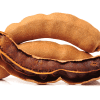Position
Tamarind loves full sun and heat. It enjoys mild winter but is not suitable for the outdoors in colder weather without frost cover. Adult trees are resistant to temperatures down to -2ºC.
Size
Tamarind can grow to 25 mts tall with a spread of about seven mts. Space the trees between 5 to 15 mts apart.
Soil Type
Tamarind prefers deep loamy soil and thrives in neutral, gritty clay. Tamarind enjoys well-drained soil with a pH of between 4.5 and 9.
Water
Water the plants when the first 3cm of soil is dry. Established tamarind trees only require little water as they can tolerate extreme drought conditions.
Pruning
Regularly prune your tamarind tree to control its growth and shape. Remove dead and damaged wood from the plant.
Fertilising
Use our slow-release nitrogen-rich fertiliser, like our all plant fertiliser (which is excellent for citrus) Apply 1 teaspoon of our berry fertiliser every 4-5 months.
Mulching
Add a thick layer of pine bark mulch, keeping it about 20 to 30 centimetres away from the tree trunk (any closer may cause excess moisture and damage the trunk). This will retain the moisture in the soil and will prevent weeds from taking over.
Pests and Diseases
Aphids, citrus psylla, red scale, citrus greening. Spraying regularly with Agricultural Neem Oil or Effective Microorganisms (EM Control ) will assist in either prevention or after the fact. If you already have aphids or mites, wash the tree with a harsh hosing, and when dry, spray with Neem oil or EM Control.
Practice good garden hygiene (remove fallen fruit and leaves).
Watch for root rot (if overwatered) and fungal infections during wet periods.
Harvesting
Tamarind fruits fall from the tree naturally or are harvested when ripe. Unripe fruits that fall from the tree aren’t collected immediately but are left on the ground until they are ripe.






